BUSN20017 - Effective Communication: Essay on Verbal Behaviors
VerifiedAdded on 2023/03/31
|11
|1830
|196
Essay
AI Summary
This essay analyzes workplace verbal communication behaviors as presented in an article by Keyton et al. (2013), focusing on the topic of the research article, the issues addressed, and their significance. The research investigates various forms of workplace verbal communication and the factors influencing effective communication behaviors, highlighting the importance of interpersonal relations and information passage within organizations. Major findings from the study are presented, including the identification of common communication behaviors and factors contributing to effective communication. The essay concludes by discussing the significance of these findings for future communication improvements, particularly in linking communication to employee performance and organizational interrelationships. Desklib provides a platform to access this and many other solved assignments.
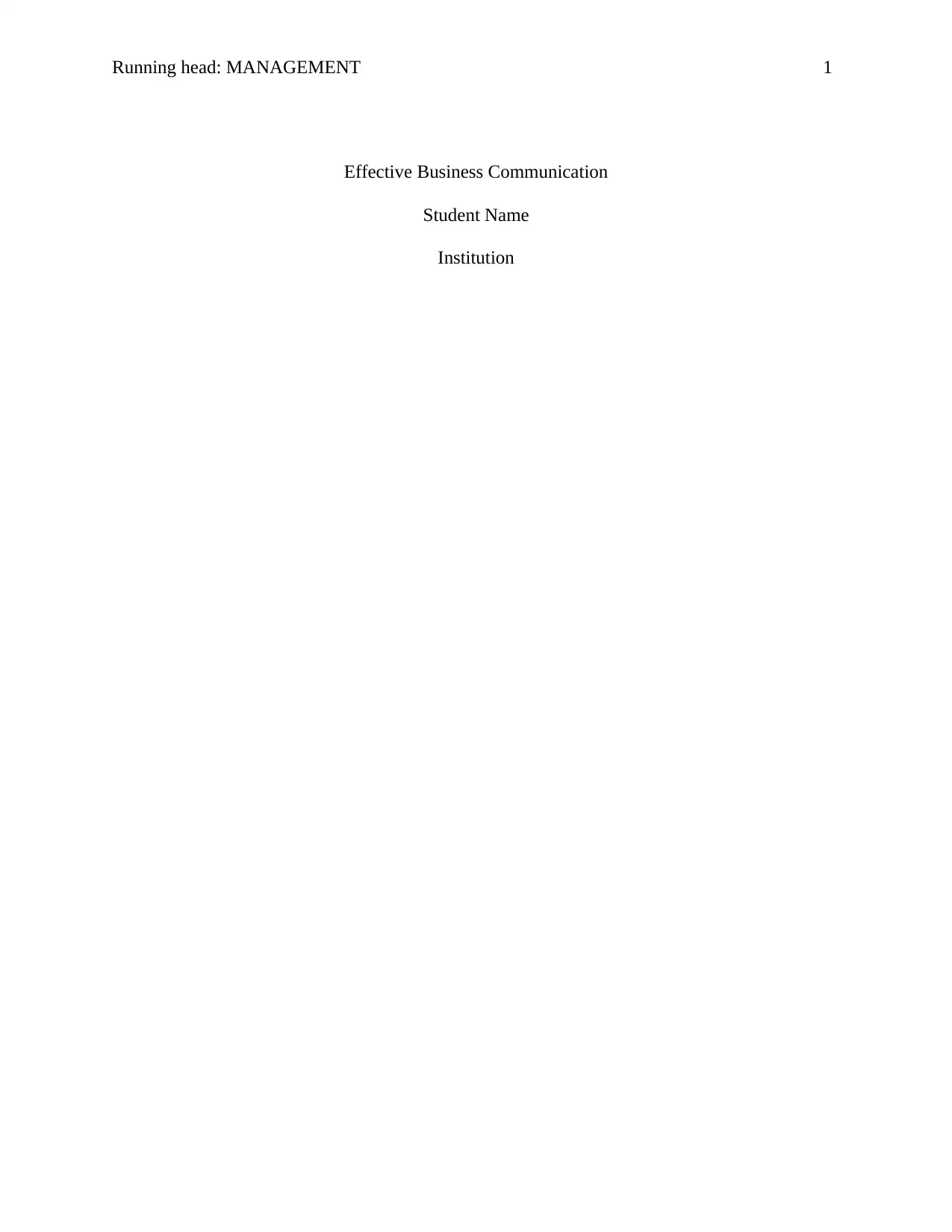
Running head: MANAGEMENT 1
Effective Business Communication
Student Name
Institution
Effective Business Communication
Student Name
Institution
Paraphrase This Document
Need a fresh take? Get an instant paraphrase of this document with our AI Paraphraser
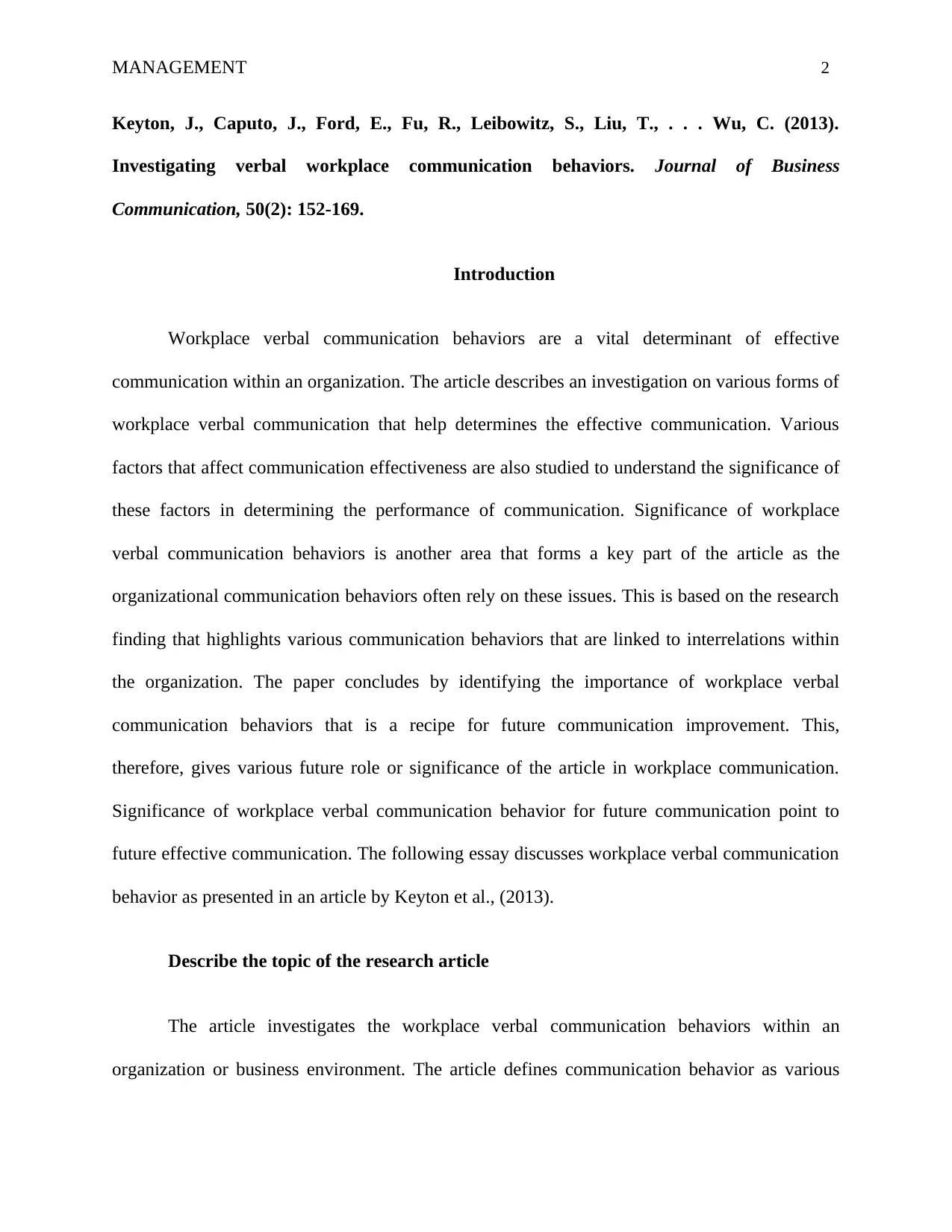
MANAGEMENT 2
Keyton, J., Caputo, J., Ford, E., Fu, R., Leibowitz, S., Liu, T., . . . Wu, C. (2013).
Investigating verbal workplace communication behaviors. Journal of Business
Communication, 50(2): 152-169.
Introduction
Workplace verbal communication behaviors are a vital determinant of effective
communication within an organization. The article describes an investigation on various forms of
workplace verbal communication that help determines the effective communication. Various
factors that affect communication effectiveness are also studied to understand the significance of
these factors in determining the performance of communication. Significance of workplace
verbal communication behaviors is another area that forms a key part of the article as the
organizational communication behaviors often rely on these issues. This is based on the research
finding that highlights various communication behaviors that are linked to interrelations within
the organization. The paper concludes by identifying the importance of workplace verbal
communication behaviors that is a recipe for future communication improvement. This,
therefore, gives various future role or significance of the article in workplace communication.
Significance of workplace verbal communication behavior for future communication point to
future effective communication. The following essay discusses workplace verbal communication
behavior as presented in an article by Keyton et al., (2013).
Describe the topic of the research article
The article investigates the workplace verbal communication behaviors within an
organization or business environment. The article defines communication behavior as various
Keyton, J., Caputo, J., Ford, E., Fu, R., Leibowitz, S., Liu, T., . . . Wu, C. (2013).
Investigating verbal workplace communication behaviors. Journal of Business
Communication, 50(2): 152-169.
Introduction
Workplace verbal communication behaviors are a vital determinant of effective
communication within an organization. The article describes an investigation on various forms of
workplace verbal communication that help determines the effective communication. Various
factors that affect communication effectiveness are also studied to understand the significance of
these factors in determining the performance of communication. Significance of workplace
verbal communication behaviors is another area that forms a key part of the article as the
organizational communication behaviors often rely on these issues. This is based on the research
finding that highlights various communication behaviors that are linked to interrelations within
the organization. The paper concludes by identifying the importance of workplace verbal
communication behaviors that is a recipe for future communication improvement. This,
therefore, gives various future role or significance of the article in workplace communication.
Significance of workplace verbal communication behavior for future communication point to
future effective communication. The following essay discusses workplace verbal communication
behavior as presented in an article by Keyton et al., (2013).
Describe the topic of the research article
The article investigates the workplace verbal communication behaviors within an
organization or business environment. The article defines communication behavior as various
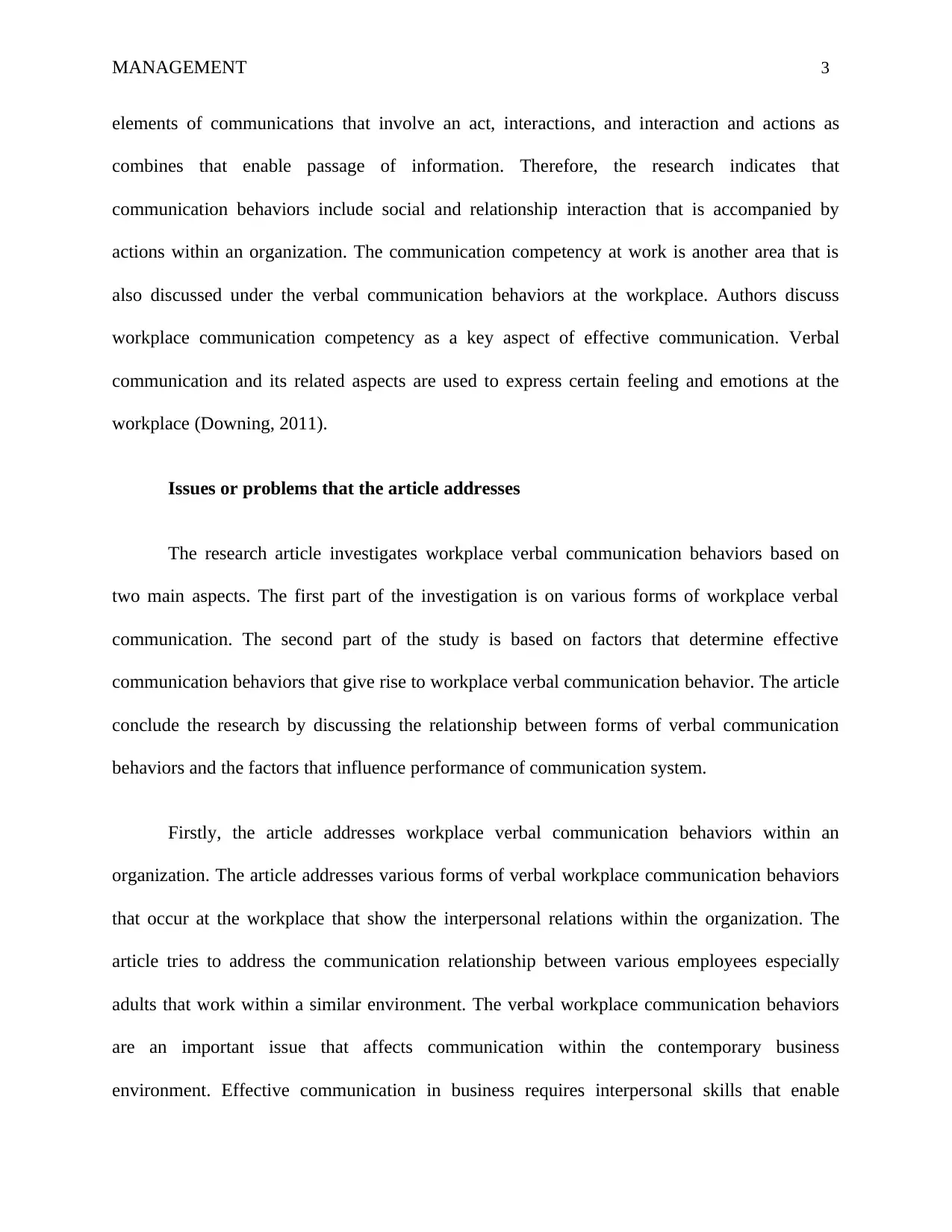
MANAGEMENT 3
elements of communications that involve an act, interactions, and interaction and actions as
combines that enable passage of information. Therefore, the research indicates that
communication behaviors include social and relationship interaction that is accompanied by
actions within an organization. The communication competency at work is another area that is
also discussed under the verbal communication behaviors at the workplace. Authors discuss
workplace communication competency as a key aspect of effective communication. Verbal
communication and its related aspects are used to express certain feeling and emotions at the
workplace (Downing, 2011).
Issues or problems that the article addresses
The research article investigates workplace verbal communication behaviors based on
two main aspects. The first part of the investigation is on various forms of workplace verbal
communication. The second part of the study is based on factors that determine effective
communication behaviors that give rise to workplace verbal communication behavior. The article
conclude the research by discussing the relationship between forms of verbal communication
behaviors and the factors that influence performance of communication system.
Firstly, the article addresses workplace verbal communication behaviors within an
organization. The article addresses various forms of verbal workplace communication behaviors
that occur at the workplace that show the interpersonal relations within the organization. The
article tries to address the communication relationship between various employees especially
adults that work within a similar environment. The verbal workplace communication behaviors
are an important issue that affects communication within the contemporary business
environment. Effective communication in business requires interpersonal skills that enable
elements of communications that involve an act, interactions, and interaction and actions as
combines that enable passage of information. Therefore, the research indicates that
communication behaviors include social and relationship interaction that is accompanied by
actions within an organization. The communication competency at work is another area that is
also discussed under the verbal communication behaviors at the workplace. Authors discuss
workplace communication competency as a key aspect of effective communication. Verbal
communication and its related aspects are used to express certain feeling and emotions at the
workplace (Downing, 2011).
Issues or problems that the article addresses
The research article investigates workplace verbal communication behaviors based on
two main aspects. The first part of the investigation is on various forms of workplace verbal
communication. The second part of the study is based on factors that determine effective
communication behaviors that give rise to workplace verbal communication behavior. The article
conclude the research by discussing the relationship between forms of verbal communication
behaviors and the factors that influence performance of communication system.
Firstly, the article addresses workplace verbal communication behaviors within an
organization. The article addresses various forms of verbal workplace communication behaviors
that occur at the workplace that show the interpersonal relations within the organization. The
article tries to address the communication relationship between various employees especially
adults that work within a similar environment. The verbal workplace communication behaviors
are an important issue that affects communication within the contemporary business
environment. Effective communication in business requires interpersonal skills that enable
⊘ This is a preview!⊘
Do you want full access?
Subscribe today to unlock all pages.

Trusted by 1+ million students worldwide
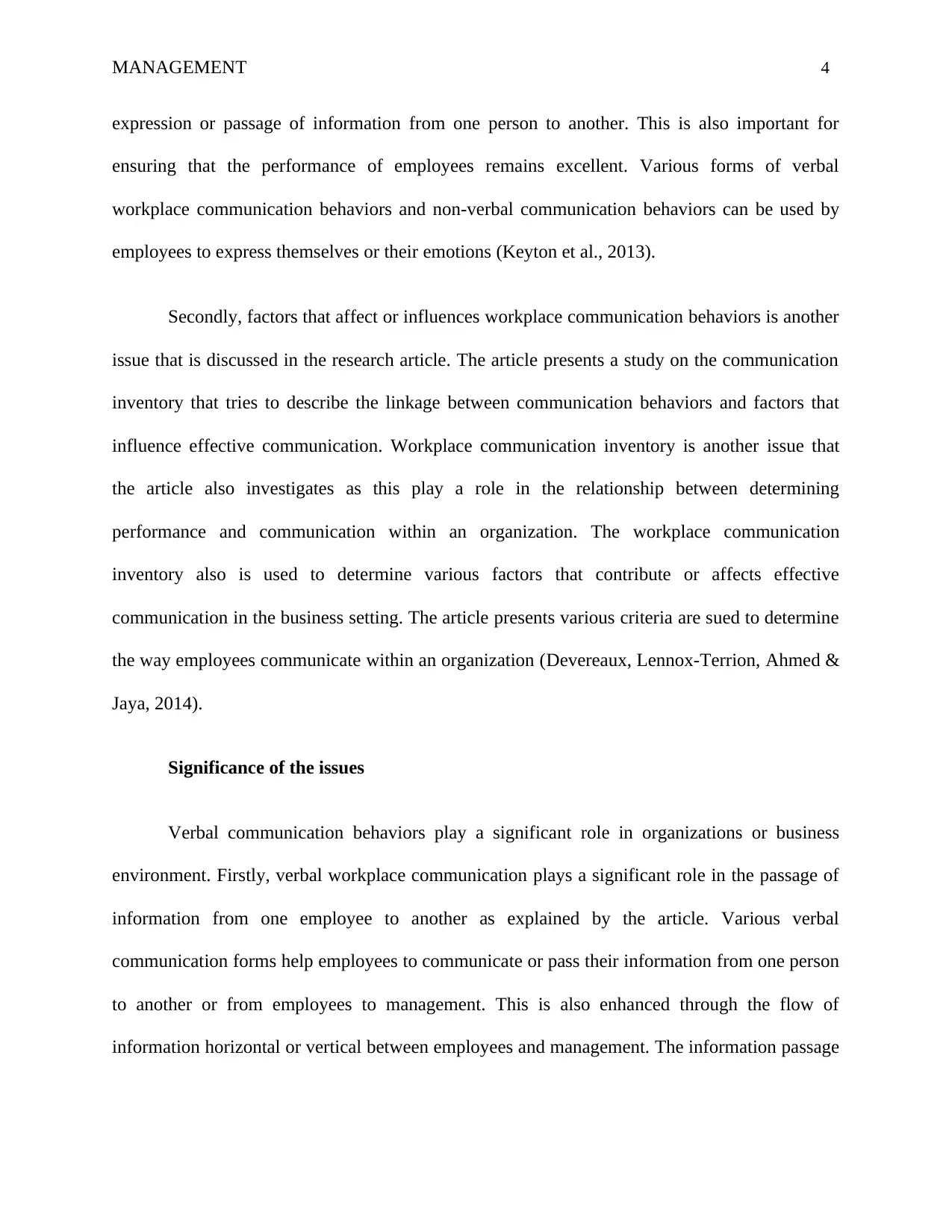
MANAGEMENT 4
expression or passage of information from one person to another. This is also important for
ensuring that the performance of employees remains excellent. Various forms of verbal
workplace communication behaviors and non-verbal communication behaviors can be used by
employees to express themselves or their emotions (Keyton et al., 2013).
Secondly, factors that affect or influences workplace communication behaviors is another
issue that is discussed in the research article. The article presents a study on the communication
inventory that tries to describe the linkage between communication behaviors and factors that
influence effective communication. Workplace communication inventory is another issue that
the article also investigates as this play a role in the relationship between determining
performance and communication within an organization. The workplace communication
inventory also is used to determine various factors that contribute or affects effective
communication in the business setting. The article presents various criteria are sued to determine
the way employees communicate within an organization (Devereaux, Lennox-Terrion, Ahmed &
Jaya, 2014).
Significance of the issues
Verbal communication behaviors play a significant role in organizations or business
environment. Firstly, verbal workplace communication plays a significant role in the passage of
information from one employee to another as explained by the article. Various verbal
communication forms help employees to communicate or pass their information from one person
to another or from employees to management. This is also enhanced through the flow of
information horizontal or vertical between employees and management. The information passage
expression or passage of information from one person to another. This is also important for
ensuring that the performance of employees remains excellent. Various forms of verbal
workplace communication behaviors and non-verbal communication behaviors can be used by
employees to express themselves or their emotions (Keyton et al., 2013).
Secondly, factors that affect or influences workplace communication behaviors is another
issue that is discussed in the research article. The article presents a study on the communication
inventory that tries to describe the linkage between communication behaviors and factors that
influence effective communication. Workplace communication inventory is another issue that
the article also investigates as this play a role in the relationship between determining
performance and communication within an organization. The workplace communication
inventory also is used to determine various factors that contribute or affects effective
communication in the business setting. The article presents various criteria are sued to determine
the way employees communicate within an organization (Devereaux, Lennox-Terrion, Ahmed &
Jaya, 2014).
Significance of the issues
Verbal communication behaviors play a significant role in organizations or business
environment. Firstly, verbal workplace communication plays a significant role in the passage of
information from one employee to another as explained by the article. Various verbal
communication forms help employees to communicate or pass their information from one person
to another or from employees to management. This is also enhanced through the flow of
information horizontal or vertical between employees and management. The information passage
Paraphrase This Document
Need a fresh take? Get an instant paraphrase of this document with our AI Paraphraser
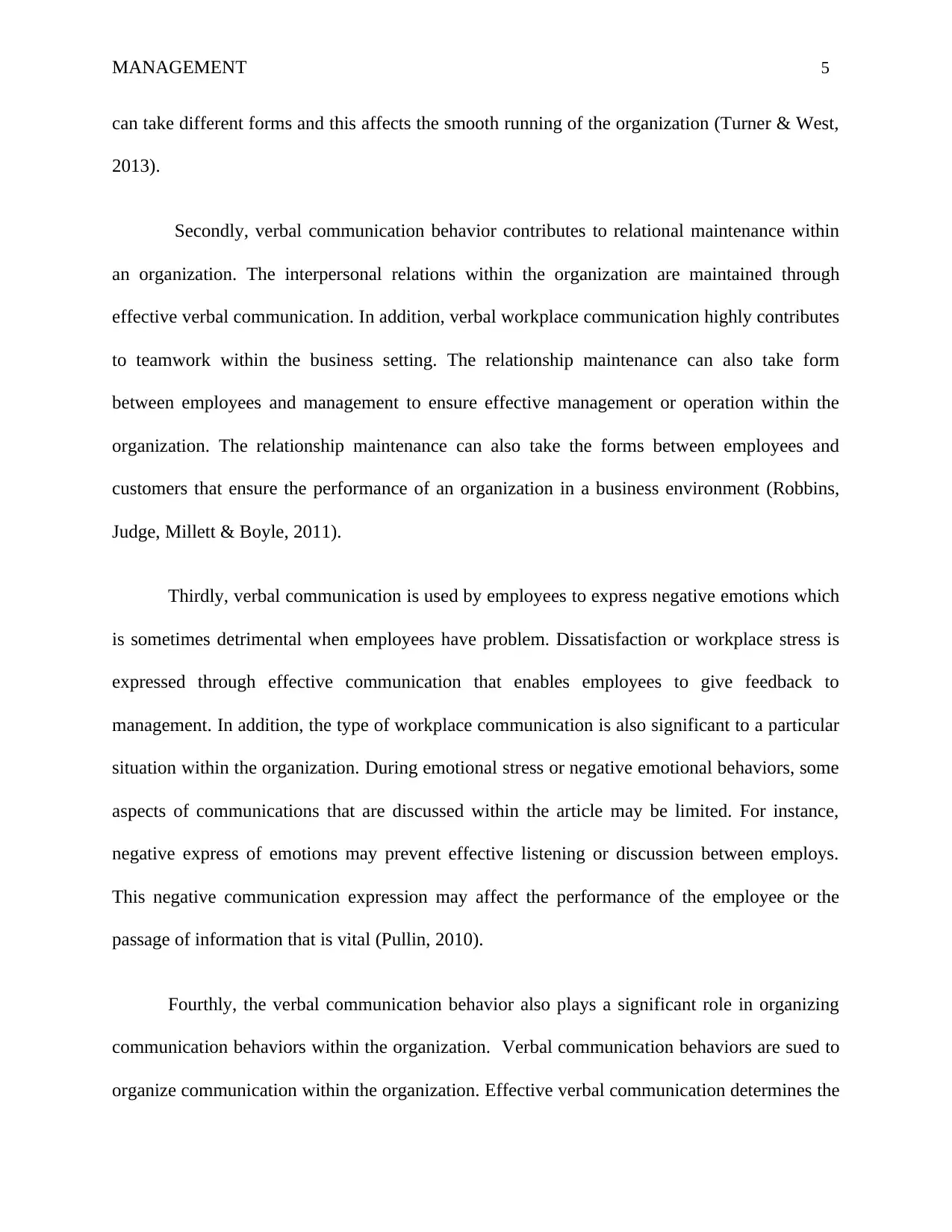
MANAGEMENT 5
can take different forms and this affects the smooth running of the organization (Turner & West,
2013).
Secondly, verbal communication behavior contributes to relational maintenance within
an organization. The interpersonal relations within the organization are maintained through
effective verbal communication. In addition, verbal workplace communication highly contributes
to teamwork within the business setting. The relationship maintenance can also take form
between employees and management to ensure effective management or operation within the
organization. The relationship maintenance can also take the forms between employees and
customers that ensure the performance of an organization in a business environment (Robbins,
Judge, Millett & Boyle, 2011).
Thirdly, verbal communication is used by employees to express negative emotions which
is sometimes detrimental when employees have problem. Dissatisfaction or workplace stress is
expressed through effective communication that enables employees to give feedback to
management. In addition, the type of workplace communication is also significant to a particular
situation within the organization. During emotional stress or negative emotional behaviors, some
aspects of communications that are discussed within the article may be limited. For instance,
negative express of emotions may prevent effective listening or discussion between employs.
This negative communication expression may affect the performance of the employee or the
passage of information that is vital (Pullin, 2010).
Fourthly, the verbal communication behavior also plays a significant role in organizing
communication behaviors within the organization. Verbal communication behaviors are sued to
organize communication within the organization. Effective verbal communication determines the
can take different forms and this affects the smooth running of the organization (Turner & West,
2013).
Secondly, verbal communication behavior contributes to relational maintenance within
an organization. The interpersonal relations within the organization are maintained through
effective verbal communication. In addition, verbal workplace communication highly contributes
to teamwork within the business setting. The relationship maintenance can also take form
between employees and management to ensure effective management or operation within the
organization. The relationship maintenance can also take the forms between employees and
customers that ensure the performance of an organization in a business environment (Robbins,
Judge, Millett & Boyle, 2011).
Thirdly, verbal communication is used by employees to express negative emotions which
is sometimes detrimental when employees have problem. Dissatisfaction or workplace stress is
expressed through effective communication that enables employees to give feedback to
management. In addition, the type of workplace communication is also significant to a particular
situation within the organization. During emotional stress or negative emotional behaviors, some
aspects of communications that are discussed within the article may be limited. For instance,
negative express of emotions may prevent effective listening or discussion between employs.
This negative communication expression may affect the performance of the employee or the
passage of information that is vital (Pullin, 2010).
Fourthly, the verbal communication behavior also plays a significant role in organizing
communication behaviors within the organization. Verbal communication behaviors are sued to
organize communication within the organization. Effective verbal communication determines the
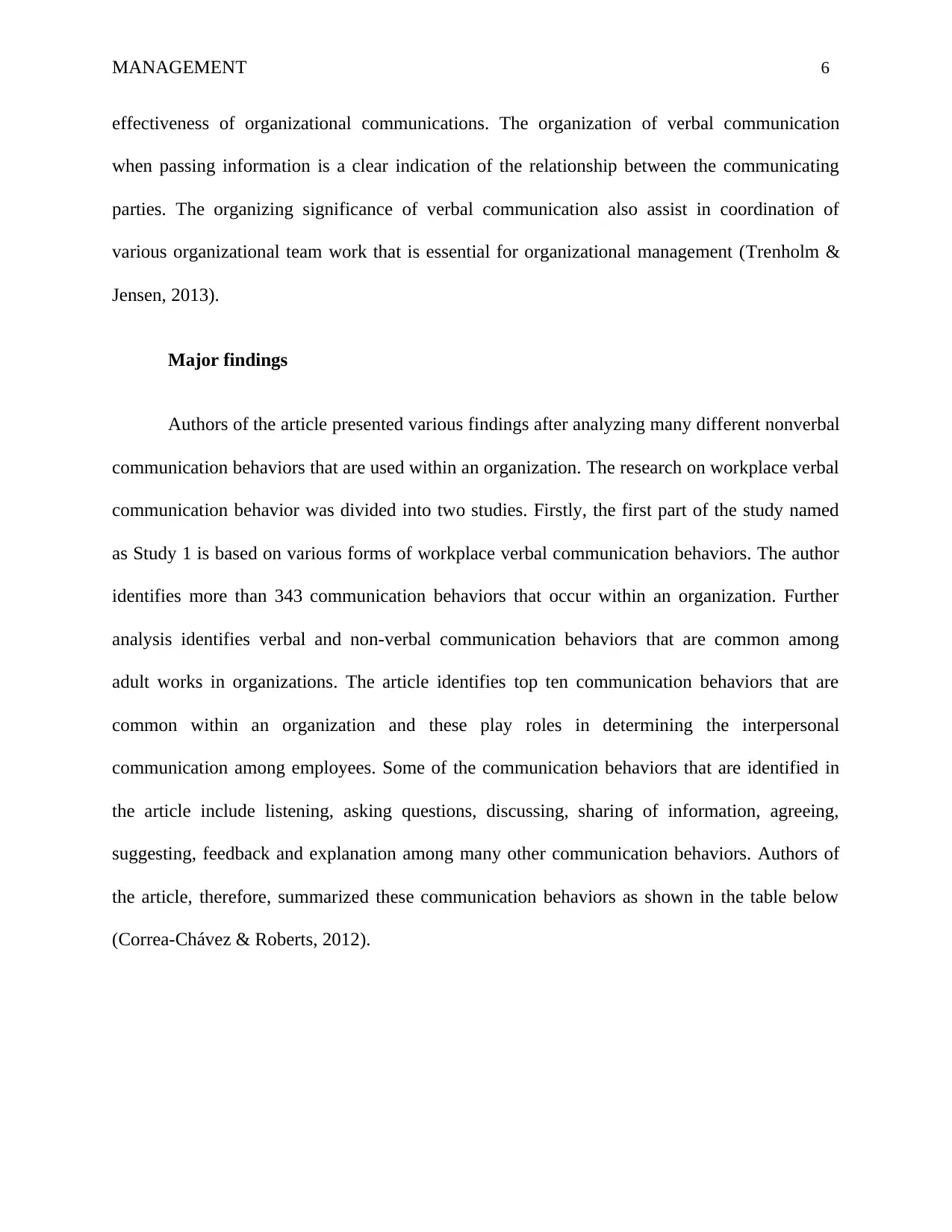
MANAGEMENT 6
effectiveness of organizational communications. The organization of verbal communication
when passing information is a clear indication of the relationship between the communicating
parties. The organizing significance of verbal communication also assist in coordination of
various organizational team work that is essential for organizational management (Trenholm &
Jensen, 2013).
Major findings
Authors of the article presented various findings after analyzing many different nonverbal
communication behaviors that are used within an organization. The research on workplace verbal
communication behavior was divided into two studies. Firstly, the first part of the study named
as Study 1 is based on various forms of workplace verbal communication behaviors. The author
identifies more than 343 communication behaviors that occur within an organization. Further
analysis identifies verbal and non-verbal communication behaviors that are common among
adult works in organizations. The article identifies top ten communication behaviors that are
common within an organization and these play roles in determining the interpersonal
communication among employees. Some of the communication behaviors that are identified in
the article include listening, asking questions, discussing, sharing of information, agreeing,
suggesting, feedback and explanation among many other communication behaviors. Authors of
the article, therefore, summarized these communication behaviors as shown in the table below
(Correa-Chávez & Roberts, 2012).
effectiveness of organizational communications. The organization of verbal communication
when passing information is a clear indication of the relationship between the communicating
parties. The organizing significance of verbal communication also assist in coordination of
various organizational team work that is essential for organizational management (Trenholm &
Jensen, 2013).
Major findings
Authors of the article presented various findings after analyzing many different nonverbal
communication behaviors that are used within an organization. The research on workplace verbal
communication behavior was divided into two studies. Firstly, the first part of the study named
as Study 1 is based on various forms of workplace verbal communication behaviors. The author
identifies more than 343 communication behaviors that occur within an organization. Further
analysis identifies verbal and non-verbal communication behaviors that are common among
adult works in organizations. The article identifies top ten communication behaviors that are
common within an organization and these play roles in determining the interpersonal
communication among employees. Some of the communication behaviors that are identified in
the article include listening, asking questions, discussing, sharing of information, agreeing,
suggesting, feedback and explanation among many other communication behaviors. Authors of
the article, therefore, summarized these communication behaviors as shown in the table below
(Correa-Chávez & Roberts, 2012).
⊘ This is a preview!⊘
Do you want full access?
Subscribe today to unlock all pages.

Trusted by 1+ million students worldwide
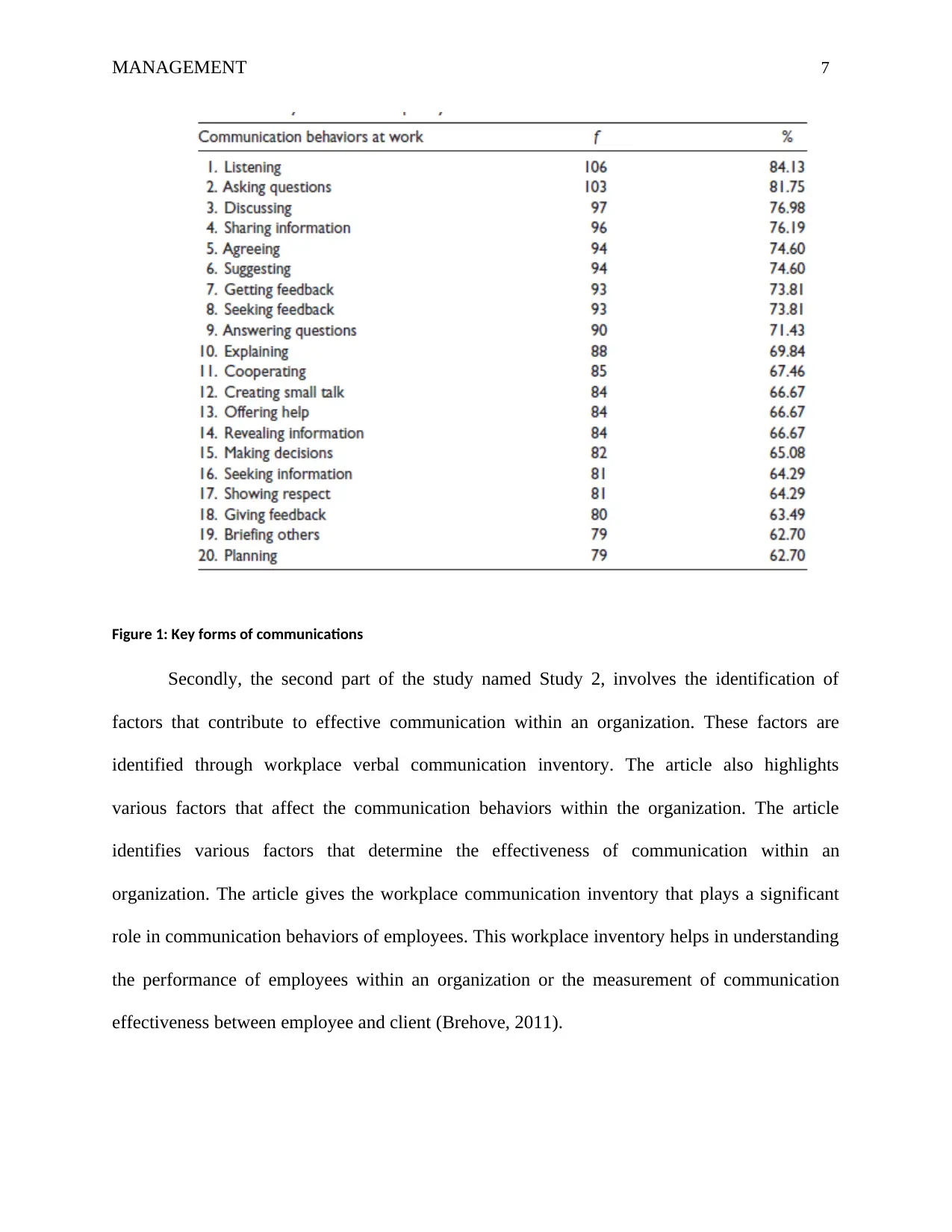
MANAGEMENT 7
Figure 1: Key forms of communications
Secondly, the second part of the study named Study 2, involves the identification of
factors that contribute to effective communication within an organization. These factors are
identified through workplace verbal communication inventory. The article also highlights
various factors that affect the communication behaviors within the organization. The article
identifies various factors that determine the effectiveness of communication within an
organization. The article gives the workplace communication inventory that plays a significant
role in communication behaviors of employees. This workplace inventory helps in understanding
the performance of employees within an organization or the measurement of communication
effectiveness between employee and client (Brehove, 2011).
Figure 1: Key forms of communications
Secondly, the second part of the study named Study 2, involves the identification of
factors that contribute to effective communication within an organization. These factors are
identified through workplace verbal communication inventory. The article also highlights
various factors that affect the communication behaviors within the organization. The article
identifies various factors that determine the effectiveness of communication within an
organization. The article gives the workplace communication inventory that plays a significant
role in communication behaviors of employees. This workplace inventory helps in understanding
the performance of employees within an organization or the measurement of communication
effectiveness between employee and client (Brehove, 2011).
Paraphrase This Document
Need a fresh take? Get an instant paraphrase of this document with our AI Paraphraser
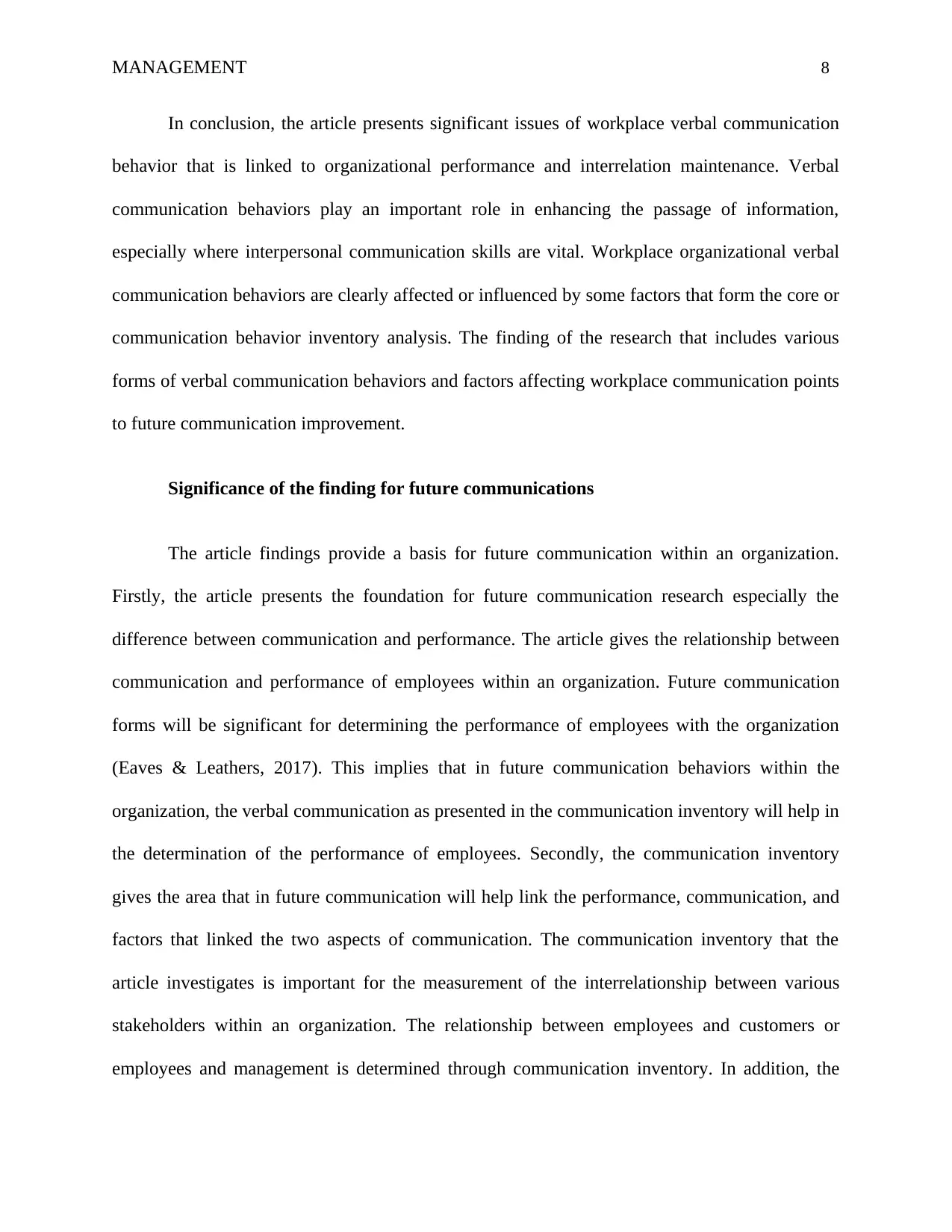
MANAGEMENT 8
In conclusion, the article presents significant issues of workplace verbal communication
behavior that is linked to organizational performance and interrelation maintenance. Verbal
communication behaviors play an important role in enhancing the passage of information,
especially where interpersonal communication skills are vital. Workplace organizational verbal
communication behaviors are clearly affected or influenced by some factors that form the core or
communication behavior inventory analysis. The finding of the research that includes various
forms of verbal communication behaviors and factors affecting workplace communication points
to future communication improvement.
Significance of the finding for future communications
The article findings provide a basis for future communication within an organization.
Firstly, the article presents the foundation for future communication research especially the
difference between communication and performance. The article gives the relationship between
communication and performance of employees within an organization. Future communication
forms will be significant for determining the performance of employees with the organization
(Eaves & Leathers, 2017). This implies that in future communication behaviors within the
organization, the verbal communication as presented in the communication inventory will help in
the determination of the performance of employees. Secondly, the communication inventory
gives the area that in future communication will help link the performance, communication, and
factors that linked the two aspects of communication. The communication inventory that the
article investigates is important for the measurement of the interrelationship between various
stakeholders within an organization. The relationship between employees and customers or
employees and management is determined through communication inventory. In addition, the
In conclusion, the article presents significant issues of workplace verbal communication
behavior that is linked to organizational performance and interrelation maintenance. Verbal
communication behaviors play an important role in enhancing the passage of information,
especially where interpersonal communication skills are vital. Workplace organizational verbal
communication behaviors are clearly affected or influenced by some factors that form the core or
communication behavior inventory analysis. The finding of the research that includes various
forms of verbal communication behaviors and factors affecting workplace communication points
to future communication improvement.
Significance of the finding for future communications
The article findings provide a basis for future communication within an organization.
Firstly, the article presents the foundation for future communication research especially the
difference between communication and performance. The article gives the relationship between
communication and performance of employees within an organization. Future communication
forms will be significant for determining the performance of employees with the organization
(Eaves & Leathers, 2017). This implies that in future communication behaviors within the
organization, the verbal communication as presented in the communication inventory will help in
the determination of the performance of employees. Secondly, the communication inventory
gives the area that in future communication will help link the performance, communication, and
factors that linked the two aspects of communication. The communication inventory that the
article investigates is important for the measurement of the interrelationship between various
stakeholders within an organization. The relationship between employees and customers or
employees and management is determined through communication inventory. In addition, the
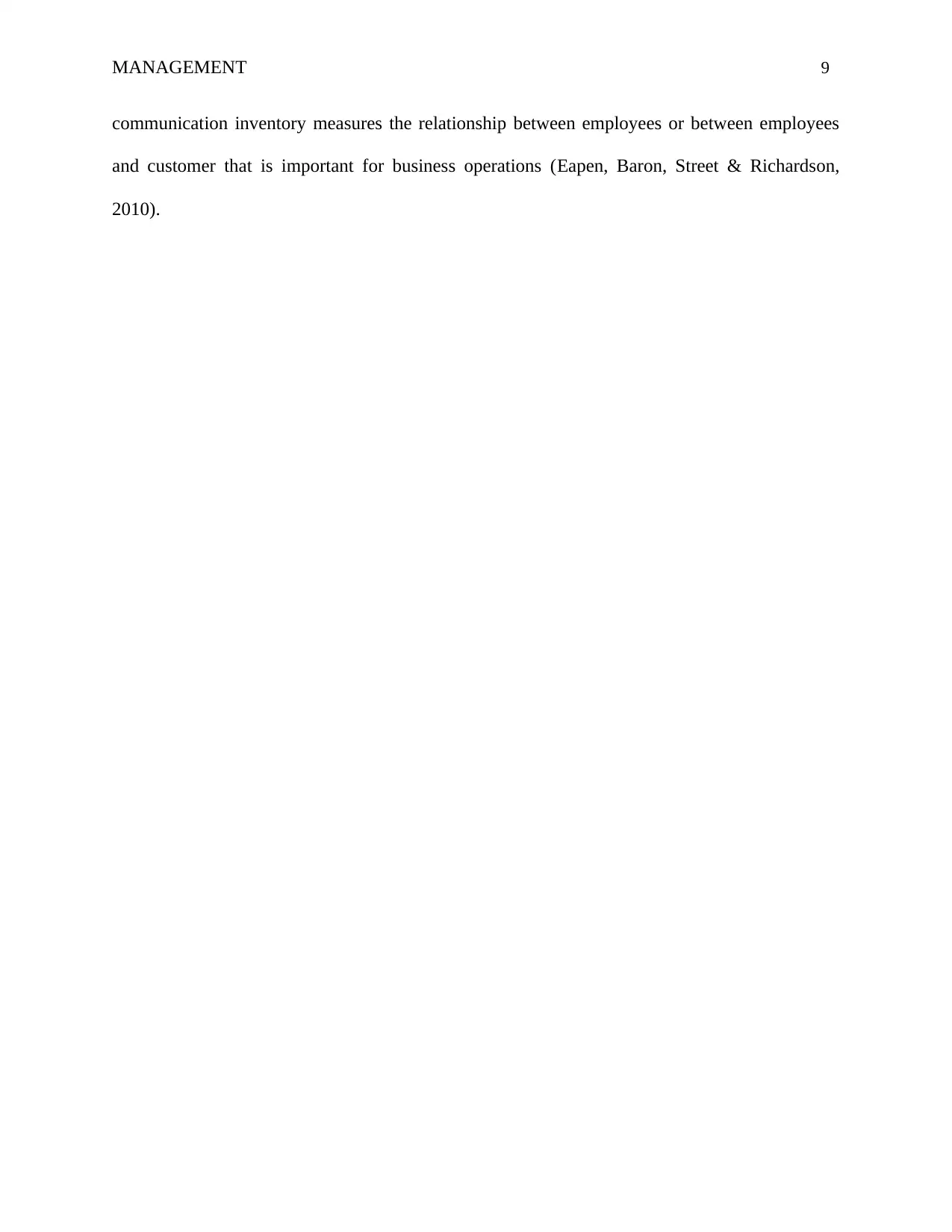
MANAGEMENT 9
communication inventory measures the relationship between employees or between employees
and customer that is important for business operations (Eapen, Baron, Street & Richardson,
2010).
communication inventory measures the relationship between employees or between employees
and customer that is important for business operations (Eapen, Baron, Street & Richardson,
2010).
⊘ This is a preview!⊘
Do you want full access?
Subscribe today to unlock all pages.

Trusted by 1+ million students worldwide
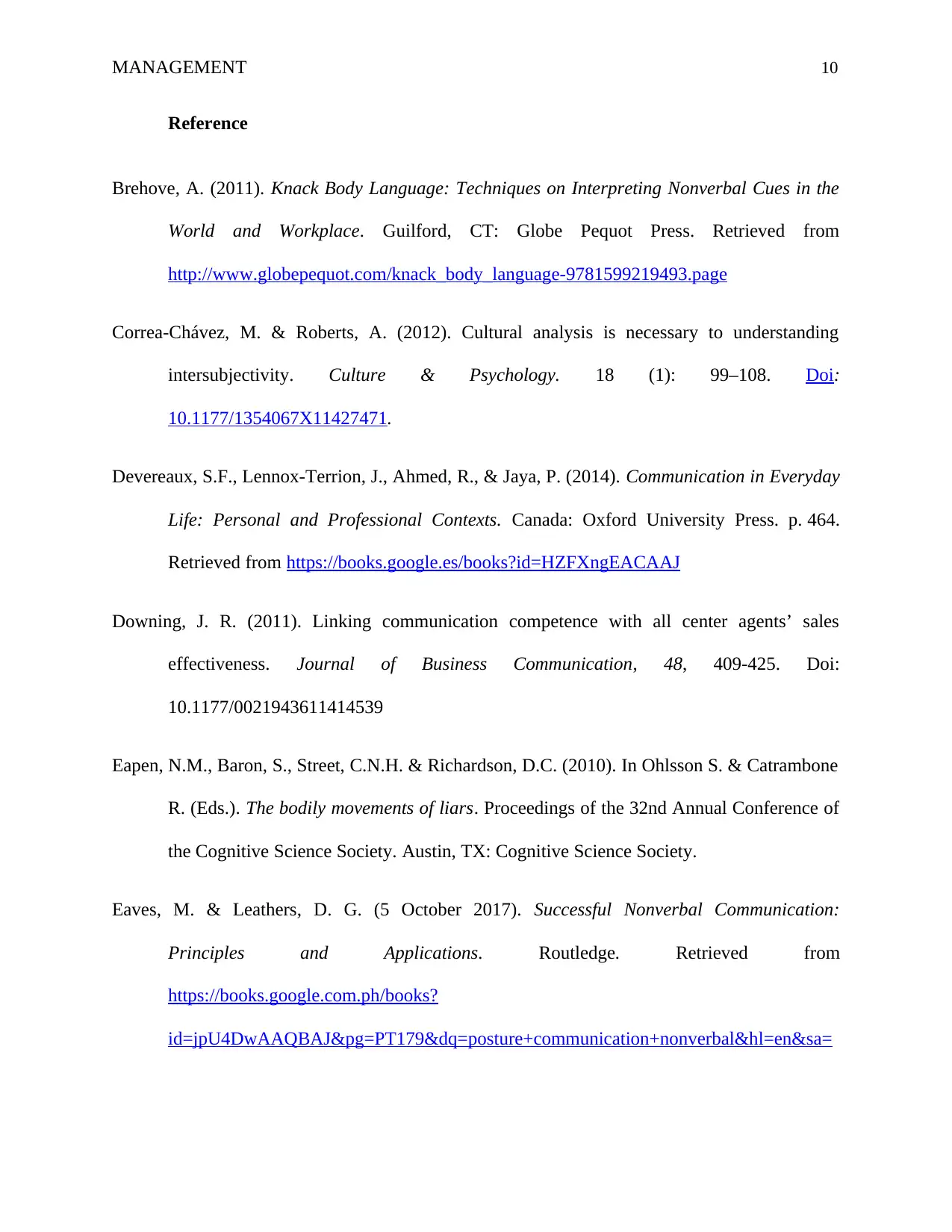
MANAGEMENT 10
Reference
Brehove, A. (2011). Knack Body Language: Techniques on Interpreting Nonverbal Cues in the
World and Workplace. Guilford, CT: Globe Pequot Press. Retrieved from
http://www.globepequot.com/knack_body_language-9781599219493.page
Correa-Chávez, M. & Roberts, A. (2012). Cultural analysis is necessary to understanding
intersubjectivity. Culture & Psychology. 18 (1): 99–108. Doi:
10.1177/1354067X11427471.
Devereaux, S.F., Lennox-Terrion, J., Ahmed, R., & Jaya, P. (2014). Communication in Everyday
Life: Personal and Professional Contexts. Canada: Oxford University Press. p. 464.
Retrieved from https://books.google.es/books?id=HZFXngEACAAJ
Downing, J. R. (2011). Linking communication competence with all center agents’ sales
effectiveness. Journal of Business Communication, 48, 409-425. Doi:
10.1177/0021943611414539
Eapen, N.M., Baron, S., Street, C.N.H. & Richardson, D.C. (2010). In Ohlsson S. & Catrambone
R. (Eds.). The bodily movements of liars. Proceedings of the 32nd Annual Conference of
the Cognitive Science Society. Austin, TX: Cognitive Science Society.
Eaves, M. & Leathers, D. G. (5 October 2017). Successful Nonverbal Communication:
Principles and Applications. Routledge. Retrieved from
https://books.google.com.ph/books?
id=jpU4DwAAQBAJ&pg=PT179&dq=posture+communication+nonverbal&hl=en&sa=
Reference
Brehove, A. (2011). Knack Body Language: Techniques on Interpreting Nonverbal Cues in the
World and Workplace. Guilford, CT: Globe Pequot Press. Retrieved from
http://www.globepequot.com/knack_body_language-9781599219493.page
Correa-Chávez, M. & Roberts, A. (2012). Cultural analysis is necessary to understanding
intersubjectivity. Culture & Psychology. 18 (1): 99–108. Doi:
10.1177/1354067X11427471.
Devereaux, S.F., Lennox-Terrion, J., Ahmed, R., & Jaya, P. (2014). Communication in Everyday
Life: Personal and Professional Contexts. Canada: Oxford University Press. p. 464.
Retrieved from https://books.google.es/books?id=HZFXngEACAAJ
Downing, J. R. (2011). Linking communication competence with all center agents’ sales
effectiveness. Journal of Business Communication, 48, 409-425. Doi:
10.1177/0021943611414539
Eapen, N.M., Baron, S., Street, C.N.H. & Richardson, D.C. (2010). In Ohlsson S. & Catrambone
R. (Eds.). The bodily movements of liars. Proceedings of the 32nd Annual Conference of
the Cognitive Science Society. Austin, TX: Cognitive Science Society.
Eaves, M. & Leathers, D. G. (5 October 2017). Successful Nonverbal Communication:
Principles and Applications. Routledge. Retrieved from
https://books.google.com.ph/books?
id=jpU4DwAAQBAJ&pg=PT179&dq=posture+communication+nonverbal&hl=en&sa=
Paraphrase This Document
Need a fresh take? Get an instant paraphrase of this document with our AI Paraphraser
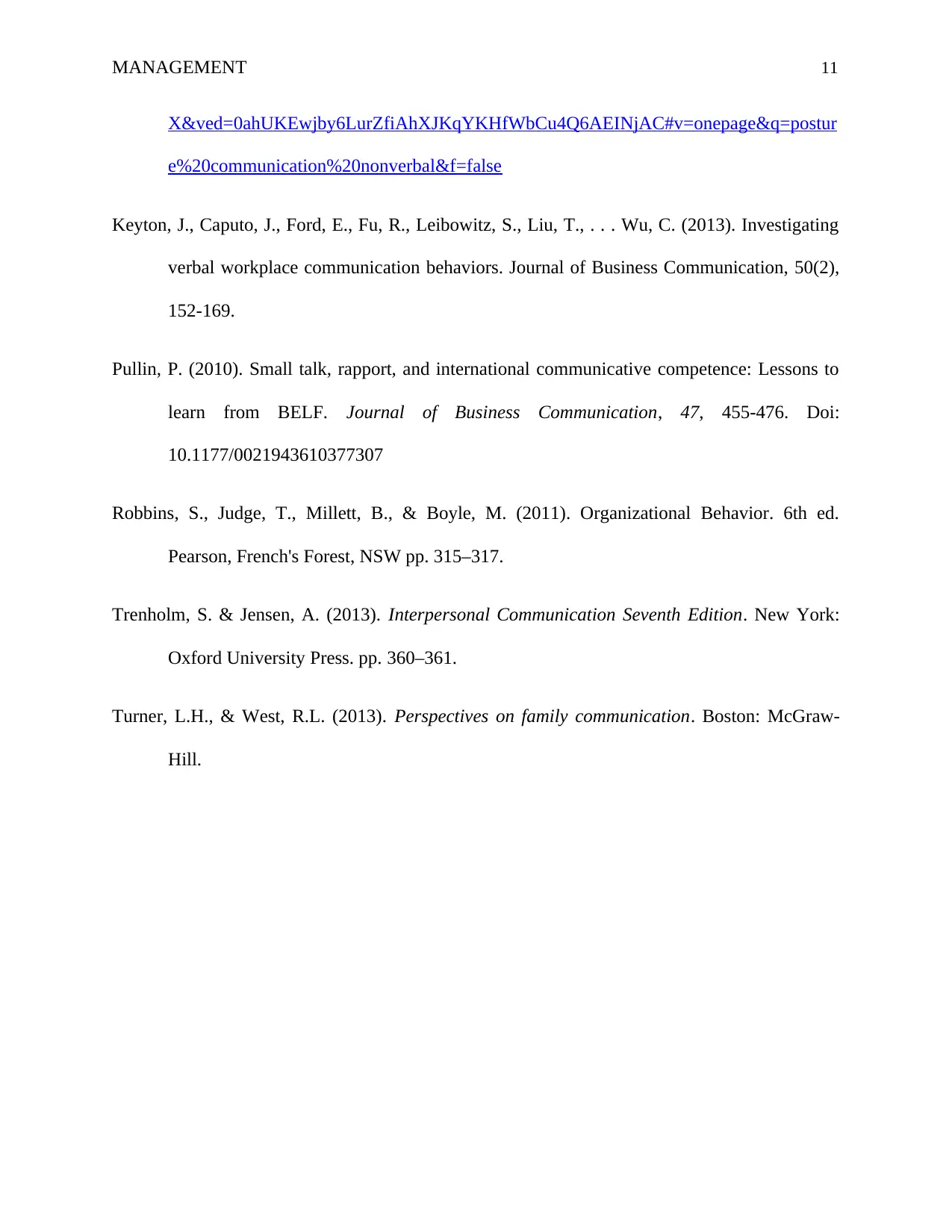
MANAGEMENT 11
X&ved=0ahUKEwjby6LurZfiAhXJKqYKHfWbCu4Q6AEINjAC#v=onepage&q=postur
e%20communication%20nonverbal&f=false
Keyton, J., Caputo, J., Ford, E., Fu, R., Leibowitz, S., Liu, T., . . . Wu, C. (2013). Investigating
verbal workplace communication behaviors. Journal of Business Communication, 50(2),
152-169.
Pullin, P. (2010). Small talk, rapport, and international communicative competence: Lessons to
learn from BELF. Journal of Business Communication, 47, 455-476. Doi:
10.1177/0021943610377307
Robbins, S., Judge, T., Millett, B., & Boyle, M. (2011). Organizational Behavior. 6th ed.
Pearson, French's Forest, NSW pp. 315–317.
Trenholm, S. & Jensen, A. (2013). Interpersonal Communication Seventh Edition. New York:
Oxford University Press. pp. 360–361.
Turner, L.H., & West, R.L. (2013). Perspectives on family communication. Boston: McGraw-
Hill.
X&ved=0ahUKEwjby6LurZfiAhXJKqYKHfWbCu4Q6AEINjAC#v=onepage&q=postur
e%20communication%20nonverbal&f=false
Keyton, J., Caputo, J., Ford, E., Fu, R., Leibowitz, S., Liu, T., . . . Wu, C. (2013). Investigating
verbal workplace communication behaviors. Journal of Business Communication, 50(2),
152-169.
Pullin, P. (2010). Small talk, rapport, and international communicative competence: Lessons to
learn from BELF. Journal of Business Communication, 47, 455-476. Doi:
10.1177/0021943610377307
Robbins, S., Judge, T., Millett, B., & Boyle, M. (2011). Organizational Behavior. 6th ed.
Pearson, French's Forest, NSW pp. 315–317.
Trenholm, S. & Jensen, A. (2013). Interpersonal Communication Seventh Edition. New York:
Oxford University Press. pp. 360–361.
Turner, L.H., & West, R.L. (2013). Perspectives on family communication. Boston: McGraw-
Hill.
1 out of 11
Related Documents
Your All-in-One AI-Powered Toolkit for Academic Success.
+13062052269
info@desklib.com
Available 24*7 on WhatsApp / Email
![[object Object]](/_next/static/media/star-bottom.7253800d.svg)
Unlock your academic potential
Copyright © 2020–2025 A2Z Services. All Rights Reserved. Developed and managed by ZUCOL.





